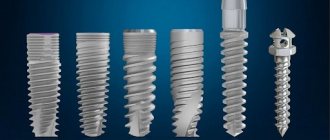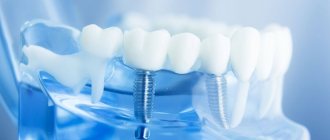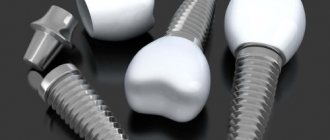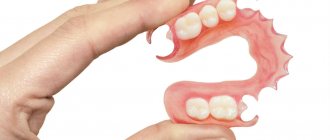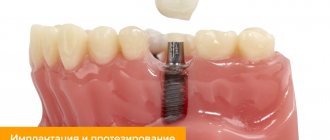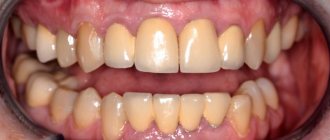Dental implantation is rapidly gaining popularity. Every year, about a million patients improve their quality of life and the aesthetics of their smile thanks to implants. There are dozens of brands and models on the service market, and they all compete with each other. Each pin released falls into a certain, albeit unofficial, category and affects the popularity of the brand. Dentists say that the best dental implantation is the one that suits the given clinical case. Why then does one implant cost 15 thousand rubles, and the other 60 thousand?
The price of an implant is influenced by many factors, primarily the manufacturer. Famous brands invest millions of dollars in research, development and search for new technologies. The high quality of their products is guaranteed, because products from well-known brands meet all the key parameters required for implants.
Let's consider what criteria influence the rating of dental implants.
Survival rate
It should be noted that for all well-known brands it is quite high, at least 97%
. However, for premium brands it is higher than 99% (Straumann, Nobel Biocare, Roott, Astra Tech). German, Israeli, Korean implants strive to achieve the same results, but their studies are not as long, this affects long-term prognoses.
The survival rate is a relative concept, because it depends not only on the quality of the pin. The skill of the implantologist and compliance with the recommendations by the patient play a big role. It is not without reason that they say that the best dental implants are those placed by a highly qualified surgeon, although other factors also need to be taken into account.
Rating of dental implants by manufacturer
Below we present a rating of implants, which indicates the most common systems in Russia. Please note that we do not rank each brand in a specific place, since without taking into account individual nuances, it is difficult to determine the best among equals. All brands are divided into categories that we have identified based on information from open sources about various implant systems, research data and expert opinion. For each item a certain number of points were awarded on a ten-point system.
Market Kings
Nobel Biocare, Astra Tech and Swiss Straumann implants are considered the three most famous systems in the world. These manufacturers have been on the market for a very long time and are at the forefront of technological solutions. Their implants allow you to count on good functional and aesthetic results even in extremely difficult cases. For all points except one (accessibility), they were given the maximum number of points.
Astra Tech (Sweden/USA)
| Survival rate | Prosthetics | Engraftment time | Indications for installation | Affordability |
| More than 99.9% (10 points) | 10 points | 10 points | 10 points | 4 points |
Straumann (Switzerland)
| Survival rate | Prosthetics | Engraftment time | Indications for installation | Affordability |
| More than 99.6% (10 points) | 10 points | 10 points | 10 points | 4 points |
Nobel Biocare (Switzerland/USA)
| Survival rate | Prosthetics | Engraftment time | Indications for installation | Affordability |
| More than 99.3% (10 points) | 10 points | 10 points | 10 points | 4 points |
Business class systems
The brands of implants listed below, in their clinical characteristics, are as close as possible to dental implants Nobel, Straumann and Astra Tech, but are inferior in some respects or do not have as many unique developments and solutions in their arsenal.
Xive (Germany–USA)
| Survival rate | Prosthetics | Engraftment time | Indications for installation | Affordability |
| More than 99.5% (9 points) | 9 points | 8 points | 9 points | 6 points |
Xive Ankylos (Germany–USA)
| Survival rate | Prosthetics | Engraftment time | Indications for installation | Affordability |
| More than 99% (9 points) | 9 points | 9 points | 9 points | 6 points |
Impro (Germany)
| Survival rate | Prosthetics | Engraftment time | Indications for installation | Affordability |
| More than 98% (9 points) | 10 points | 9 points | 8 points | 6 points |
Biohorizons (USA)
| Survival rate | Prosthetics | Engraftment time | Indications for installation | Affordability |
| More than 97.3% (9 points) | 8 points | 8 points | 8 points | 6 points |
NDI Medical (Germany)
| Survival rate | Prosthetics | Engraftment time | Indications for installation | Affordability |
| About 99.4% (8 points) | 7 points | 7 points | 7 points | 10 points |
Osseointegration time
In order for a titanium post to perform all the functions of a natural tooth, it must be covered with bone tissue. This phenomenon is called osseointegration. Only after its completion the implant becomes stable and ready for prosthetics. In the classic protocol, implantation is carried out in 2 stages. 10-15 years ago between installation and prosthetics took from 6 to 9 months
. Modern design and coating of implants from leading companies have reduced this time to 2, maximum 3 months. So, which implants are best placed also depends on how long the patient is willing to wait for the completion of the osseointegration process.
Why we chose Nobel Biocare
- The company has existed since 1965, during which time modern implantation methods and innovative technologies have been developed.
- The implant survival rate is 99.9% . This is ensured by a porous surface that has a high ability to integrate into the bone.
- The surface of TiUnite implants is a patented development of the company. Therefore, engraftment is quick and uncomplicated. Bone cells perceive the porous texture of the artificial root as a biological material, so the chance of rejection is small (only 0.7%).
- Titanium roots are produced by vacuum casting, which makes the surface perfectly smooth. The implants are durable, lightweight, and do not unduly load the jaw.
- The model range is represented by a wide range for various clinical situations. Artificial roots have a special conical shape, which simplifies penetration into the bone and eliminates the risk of injury.
- Installation is carried out in 1 or 2 stages, possible with complete edentia or bone deficiency.
- The implants also act as a support for a bridge with metal-free crowns using Procera technology. Crowns are made of zirconium dioxide, transparent like natural enamel, do not cause allergies and do not change color over time. They are even suitable for chewing posterior teeth. Prosthetics are possible immediately after installation, without waiting for healing.
- The implants are given a lifetime guarantee, each product receives an individual number to avoid counterfeiting.
- The price of implants depends on the model. Our Center provides a case pricing system - this is the turnkey cost of all implantation work from preparation to permanent prosthetics.
Bone Volume Requirements
After tooth loss, atrophy (loss) of bone tissue begins. This leads to negative consequences, one of which is the impossibility of implantation in the future. The bone is too thin for an implant. In addition, it is not dense enough to provide high primary stability. Of course, leading manufacturers have provided for such clinical cases and produce pins for cortical, zygomatic (where the tissue is denser) implantation or compression pins that compact the bone along the movement of the thread.
Israeli manufacturers have also achieved great success in producing products for installation in bone tissue of different densities. Korea is somewhat behind here. They, for example, have neither pterygoid (pterygoid) nor zygomatic models. If we are talking about severe atrophy, the answer to the question “Israel or Korea?” obvious. But Switzerland or Israel - it depends on other factors. If the bone is dense and there are no complications, then Korean or Israeli implants will perform their functions perfectly.
Causes and consequences of missing chewing teeth
Chewing units are molars and premolars, of which there are exactly 20 in the oral cavity of an adult. They are at the same time the most resilient, but the most vulnerable. They have a special anatomical structure, a tuberous platform, and several root processes. Withstand high loads. At the same time, molars are more susceptible to caries than those located in the frontal regions. Food debris accumulates in the tubercles and narrow interdental spaces; cleaning is difficult due to remote access. This leads to premature loss of units.
What are the consequences of long-term absence of chewing teeth?:
- thinning and subsidence of the alveolar ridge;
- activation of atrophic processes;
- the dentition begins to move apart, forming interdental gaps;
- the antagonist tooth moves upward in search of support on the opposite jaw;
- The necks of neighboring units, not protected by enamel, are exposed;
- periodontal ligaments are weakened;
- the risk of developing caries increases;
- displacement of the remaining teeth leads to changes in the bite;
- functionality deteriorates, which threatens the development of gastrointestinal diseases;
- the profile changes: the lower third of the face shortens, the cheeks “sag”, and wrinkles appear.
Removal of one molar unit triggers an “avalanche-like” process of changes in the dentofacial region. Timely recovery will help to avoid irreversible consequences.
Prosthetics prospects
Completion of osseointegration is not the end of the process. Now you need to put the prosthesis on the artificial root. It can be single (crown), bridge or full jaw. Comfort when chewing, diction, and aesthetics depend on the capabilities of prosthetics. The wider they are, the better for the patient, especially in complex clinical cases. Therefore, dentists say that when choosing an implant, you need to focus not only on the manufacturer, but also on the condition of the patient’s jaw. The question is not whether Korean or German, Swiss or Israeli implants are, but which of them are better suited for a particular case.
Dental implant survival rate
As a rule, the cost of an implant directly depends on the manufacturer. However, it is wrong to think that the patient pays for the brand and its popularity. Scientific research and development of new technologies require significant costs, but they help improve product quality and increase the survival rate of implants. And what could be more important for a person who dreams of a perfect smile than the absence of complications after implantation of a titanium root? To make the right choice, check out the implant survival rate, compiled based on official data from manufacturers.
| Brand and country of manufacturer | Survival rate |
| Astra Tech (Sweden/USA) | 99,9 % |
| Straumann (Switzerland) | 99,6 % |
| Alpha Bio (Israel) | 99,6 % |
| Xive (Germany) | 99,5 % |
| NDI Medical (Germany) | 99,4% |
| Nobel Biocare (Switzerland/USA) | 99,3 % |
| Osstem (South Korea) | 99,2 % |
| Bicon (USA) | 99 % |
| Ankylos (Germany) | 99 % |
| Biomet 3I (USA) | 98,5 % |
| Impro (Germany) | 98 % |
| Dentium (South Korea) | 98 % |
| BioHorizons (USA) | 97,3 % |
| MIS (Israel) | 97 % |
| Adin (Israel) | 96 % |
Indications and contraindications for installation
The price of Korean, Israeli, and even more so Russian and Chinese implants is much lower than that of leading companies from Sweden, Switzerland and Germany. But they also have enough restrictions. In case of hepatitis, HIV, and cancer, the question of which implants to install: Korean or Swiss is not worth it. Because Korean companies include these diseases in the list of contraindications. Manufacturers from Sweden, Switzerland, and Germany offer a line of products that can be used for complex systemic diseases. No matter how hard companies from Israel or Korea try to catch up with them, they have not yet been able to significantly reduce the list of contraindications. However, it decreases every year; competition forces investment in new developments of pins that will suit more patients.
Bridge or implant - which design is better?
A bridge consists of several suspended artificial crowns that are supported by two supporting outer teeth. Before prosthetics, the supporting units are depulped and ground. Bridges are made of: metal-ceramics, solid ceramics, plastic, gold-plated metal.
Installing a bridge will prevent displacement of the dentition and changes in the bite, but has many disadvantages:
- the need to remove the neurovascular bundle in healthy teeth;
- uneven load distribution threatens the rapid loss of support units;
- lack of chewing pressure on the bone in the area of pendant crowns will lead to atrophy;
- chafing, inflammation of the gums under the denture;
- short service life (8-10 years).
Which is better - a bridge or an implant? The choice of the optimal method for restoring lost teeth can only be made by a specialist based on diagnostic studies, taking into account the patient’s preferences and capabilities.
- Complete restoration of the dentition in just 4 days!
more detailsRoott Pterygoid Implants Sinus lift is no longer needed!
more details
Once and for life! Express implantation in 4 days with a permanent ReSmile prosthesis
more details
All-on-4, All-on-6, ReSmile, Zygomatic implantation We use all modern methods of dentition restoration
more details
Types of implants
Classic dental implants consist of 2 parts: a pin and an abutment, an adapter on which an artificial crown is fixed. But over time, a new generation of pins appeared, where the abutment and the pin represent a single whole (multi-units).
Classification is carried out:
- By type of design
. 2-unit for classic protocols and multi-unit for protocols with immediate load. - According to the installation protocol
. Prosthetics on implants with delayed loading are carried out after engraftment. The immediate loading protocol allows the design to be used immediately. - By installation method
. Single-stage implantation means that the pin is inserted immediately after tooth extraction, into a fresh socket. The transgingival method is used if the tooth was lost some time ago. A puncture is made in the gum, then a pin is screwed into it. The traditional method is to remove a flap of gum, insert an implant, and then apply sutures.
The doctor decides which dental implants are best to choose after a thorough diagnosis. It determines the presence of systemic diseases, periodontal conditions, and bone density. Then he selects pins depending on their purpose. This takes into account the type of connection between the pin and the abutment, the angle of inclination, the coating of the rod, its diameter and length. Product varieties help make this choice more accurate.
How the TOP brands are formed by quality and prices
When compiling the rating, the following indicators are taken into account:
- Price - one brand name can immediately add 15% to the cost. Elite brands cost more because they spend money on development and research to improve the quality of implantation systems.
- Survival rate is the proportion of implants that have taken root according to the results of long-term data studies. For the top ones, the figure is close to 100%, while the budget ones score 90-98%. But to a greater extent, this indicator depends not on the brand, but on the doctor’s experience.
- The period of osseointegration is the period of engraftment, fusion of the artificial root with the jaw bone. The average time is 3-6 months; for premium segment implants, osseointegration is reduced to 1.5-2 months.
- Warranty obligations of the manufacturer's company - all manufacturing companies provide a guarantee for the implant, and not for its service life. The indicator for budget systems tends to be 20 years, for premium systems it is lifetime.
Above are the criteria by which patients make a choice in favor of one or another implantation system. But the rating is based not only on them - there are indicators that only an implantologist can evaluate:
- material;
- surface type;
- shape, carving;
- the lineup.
German quality Ankylos
German Ankylosis implants, used in the clinics of the German Implantology Center, are distinguished by a special thread and a special type of porous surface, which is patented. The thread of the implants is arcuate. Ankylosis implants have an ideal fit of the gingival part, which makes the product in demand for the restoration of the frontal row. Artificial roots of this German brand take root approximately 2 times faster than inexpensive implants used in other clinics such as Impro and Biohorizons. Clinical and practical observations show that Ankylos implant systems are stable in bone even decades after their installation.
Italian implants
Leader implants
C-Tech implants
BTK implants
Three decades ago, there were only a few implant manufacturers, and the procedure itself was mainly performed in European countries. Now the number of brands has increased significantly, so many patients begin to get confused when choosing a particular implant. Models of different brands have their own design features, which are sometimes very significant and fundamental.
In this article we will look at the features of Italian implants. Let us clarify right away: the network of clinics “STOMPRACTICA.RF” does not work with implants from Italy.
Complications after dental implantation
On the first day, swelling, hematomas and redness may appear in the surgical area. Local reactions can last from three days to two weeks. Late problems include peri-implantitis and implant failure. This occurs due to inflammation of the jaw bone around the post. First, the patient notices redness of the gums around the prosthesis, later mobility of the implant and its loss appear.
But we use modern implant systems and proven medical protocols, which minimizes the risk of unpleasant consequences. And the highly qualified doctors completely exclude the development of serious complications.
Astra Tech: premium quality
Brand Astra Tech
– one of the three world leading manufacturers of dental implants. The company's production facilities are located in Sweden. The range of implants is varied and can be adapted to a non-standard clinical case.
The pins themselves are made of highly purified medical grade titanium alloy (grade 4). Microthreads are used on the neck of the implant, which helps distribute the load on the bone during chewing. The surface, enriched with fluoride ions, has an optimal roughness that stimulates fusion with the bone.
Recommendations after implantation surgery
After dental implantation, the dentist must give instructions for caring for the postoperative area and for drug therapy. In the early period, doctors often prescribe antibacterial and anti-inflammatory drugs. They will reduce pain and avoid wound infection.
After installing the titanium root, it is necessary to keep the oral cavity clean and use baths with antiseptic solutions. To clean the enamel for the first time, it is better to choose a soft brush. In the first days, physical training, smoking and drinking alcohol should be avoided. Food should be gentle and not hot. Following the recommendations will help avoid complications in the postoperative period.
Straumann: restores health and self-confidence
The company from Switzerland produces high-quality implants, tested in its own scientific laboratory. The German Implantology Center selects proven Straumann implant models that have proven their clinical and practical effectiveness:
- Universal pins with a sealed abutment-implant connection.
- SLA coated options. The composition accelerates the installation of an artificial root and promotes rapid tissue restoration.
Preferring a well-known brand, you will receive dental implantation in the Center’s clinics relatively inexpensively and of high quality.
Cons of dental implants
Discomfort in the first days is the main disadvantage of the intervention. In addition, implant engraftment may be accompanied by:
- pain of varying degrees of severity;
- the occurrence of edema and hyperemia; increased body temperature and general malaise;
- the formation of hematomas and bruises on the face.
These negative consequences can change your usual lifestyle, so you should not make serious plans for the next 24 hours. If the surgical field is large, the attending physician may recommend taking sick leave for the postoperative period.
Dental implantation is a very convenient, low-traumatic and effective way to recreate a lost smile, but it is not suitable for all people due to the presence of health problems in which the implant may not take root. To reduce the risk of rejection, we take a responsible approach to the design of medical actions.
Leader implants
Italian Leader dental implants are made of modern materials using the latest technologies. In terms of quality, they are not inferior to their counterparts from Germany and the USA, and at the same time they have a significant advantage - an affordable price. This is explained by the fact that Italy relatively recently entered the global implantology market, but is already taking rapid steps towards development in this area.
The surface of Leader implants is treated with special acids of organic origin to form a porous structure - this is done to ensure that the implants heal successfully. In addition, pre-treatment is carried out, which prevents the development of infection in the tissues.
The product range is represented by implants of various types, for example, there are models for weakened bone tissue, to ease the load on the gums, and others.
Despite the fact that our clinic does not use Italian implants, we cooperate with Stefano Maraviglia himself, the head of the dental surgery department in one of the clinics in Naples and a member of the Order of Malta. Stefano highly appreciated the implants used in our clinic when he came to Chelyabinsk to exchange experience with Russian specialists.

